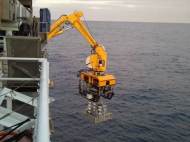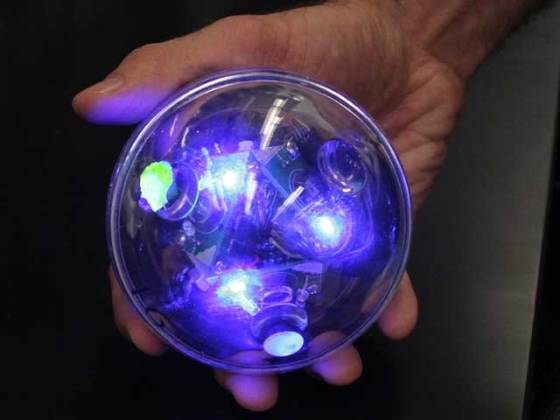Sensorbots to be used in deep ocean monitoring
 Arizona State University researchers are using their automation, sensors, biotechnology, and systems expertise to develop Sensorbots – spherical robots equipped with biogeochemical sensors that are affordable enough to be deployed by the hundreds. Sensorbots will be used to monitor the ocean in the National Science Foundation’s Ocean Observatories Initiative named Regional Scale Nodes (RSN) project.
Arizona State University researchers are using their automation, sensors, biotechnology, and systems expertise to develop Sensorbots – spherical robots equipped with biogeochemical sensors that are affordable enough to be deployed by the hundreds. Sensorbots will be used to monitor the ocean in the National Science Foundation’s Ocean Observatories Initiative named Regional Scale Nodes (RSN) project.
“The Sensorbots will enable continuous spatiotemporal monitoring of key elements in the ocean and the ability to respond to events such as underwater earthquakes and hydrothermal vents. Such research is essential for a more thorough understanding of the multiple systems in the oceans—microbes and other sea life, geology, and chemicals”, said Professor Deirdre Meldrum, ASU Senior Scientist and Director of the Center for Biosignatures Discovery Automation at Arizona State University’s Biodesign Institute.
Assistant Research Professors Cody Youngbull and Joseph Chao are both integral members of the Sensorbot team and have spent years developing the technology. Led by Professor John Delaney of the University of Washington, the RSN project involves the construction of a cabled underwater observatory in the NE Pacific Ocean, off the coasts of Oregon, Washington, and British Columbia on the Juan de Fuca tectonic plate.
The cabled observatory with high power and bandwidth provides the Sensorbots with the ability to recharge their batteries and download their data, allowing immediate information access via internet. The current Sensorbots are fist-sized transparent robotic orbs, which house electronics and batteries, while their surfaces have 3 sensors used to measure pH, temperature or oxygen. Sensorbots sense their surrounding environmental conditions, and the inner electronics convert the signal into brilliant blue flashes of light which are recorded by a high-speed camera situated on the seafloor.
The recorded signals are afterwards decoded aboard the ship. As sensorbot technology develops, these orbs may blanket large areas of the ocean and transmit information regularly to a central data hub. Ultimately, Sensorbots will be capable of operating in semi-autonomous robotic swarms, moving under remote control, in a 3D geometric formation through precisely controlled volumes of seawater.
Sensor swarms operating autonomously could function in complex, harsh, and remote environments. With appropriate microanalytical systems mounted on the Sensorbot platforms, these synthetic mariners could perform spatially and temporally indexed genomic analyses of microbial communities, as well as observing a broad variety of macro events.
The latest iteration of Sensorbot, known as p3N, will function independently and provide networking capabilities, allowing members of the swarm to communicate with each other. The optical signals transmitted by the Sensorbots will be linked, using so-called multi-hop networking technologies, not unlike those used for cell phone and other land-based wireless networks. The new p3N Sensorbots will also feature inertial monitoring units, allowing them to sense when and where they have been moved, and the researchers plan to add onboard propulsion systems in future.
Rather than delivering a very expensive robot to a single point in space and then serially moving it around, often missing dynamic phenomena, an array of inexpensive Sensorbots can cover a wide field, permitting real-time investigations of earthquakes or changes in underwater biological blooms.
“Networking will allow us to trail sensorbots like a string of pearls over great distances—so we’ll get all the benefits of optical communication speed and energy efficiency without the detriment of optical loss and attenuation in sea water”, said Youngbull.
The group will be continuing their Sensorbot experiments in a new undersea cabled environment belonging to the Monterey Bay Aquarium Research Institute (MBARI). While the Biodesign Institute team’s focus will be on undersea microbial research, the technology could be used in other potential applications, including epidemiology, national security, and contaminant plume monitoring.










Polluting the environment to monitor pollution?